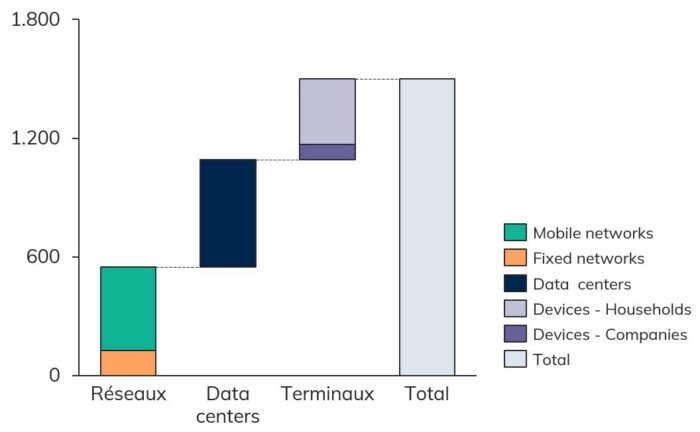
The electricity consumption of digital technologies is not anecdotical. It is likely to triple in the next 10 years, according to a recent exploratory study by Climact. While digitalisation can help other sectors to reduce their environmental impact, it is nevertheless necessary to anticipate this evolution to ensure that the climate objectives of Wallonia and Belgium are met.
A first exploratory study to estimate the electricity consumption of the digital sector.
As everyone knows, digital solutions have been massively deployed in recent years, from our connected watches to cloud-based dematerialized applications.
However, the impact of the ICT on the upcoming energy transition is not well known yet. While digital solutions can help reduce the emissions of certain sectors (building heating automation, improvement of the electricity grid, applications for sharing assets such as cars, etc.), they have a significant impact in terms of use (energy consumption), production and end-of-life.
At the request of the Department of Energy of the Public Administration of Wallonia and the Walloon Air and Climate Agency, CLIMACT conducted a first exploratory study to estimate the electricity consumption of the use of digital solutions in Wallonia and its impact on the regional climate targets by 2030.
The electricity consumption of the use of ICT in Wallonia is about 1.4 TWh, which is equivalent to more than 90% of the Walloon onshore wind production and more than the annual consumption of Belgian trains.
Based on the scientific literature, experts interviews and a “Bottom-up” analysis, CLIMACT estimates that the electricity consumption for the use of digital technologies in Wallonia is about 1.4 TWh. This consumption includes the consumption of households and business terminals (screens, computers, smartphones, etc.), networks (fixed and mobile) and data centers (see Figure 1). This represents about 8% of Walloon electricity consumption1, which is equivalent to more than 90% of Walloon wind power production2 , and more than the annual consumption of Belgian trains3. In addition, about 0.4 TWh of electricity is required for manufacturing the equipment, which is often located outside Wallonia. In terms of energy (beyond electricity), more than half of the consumption is related to the production of the equipment.
Figure 1: Bottom-up estimate of the electricity consumption of the Numeric linked to usage in Wallonia in 20184.

This estimation therefore does not include the number of Internet of Things sensors, which will soon be massively deployed and considerably increase the amount of data transferred and stored.
This consumption could triple by 2030.
The consumption of equipment and infrastructure is expected to grow rapidly and particularly from 2025 onwards. This increase will be mainly driven by the consumption of networks and data centers, while the consumption of terminals will stabilize or even decrease, thanks to energy efficiency improvements.
Figure 2: Future electricity consumption of ICTs in Wallonia by type of equipment, in an expected scenario5.

The corresponding greenhouse gas emissions will also triple by 2030, but following a more linear trend compared to electricity consumption as a result of the expected evolution of the Belgian electricity mix around 2025. Given the climate ambition of the region, Belgium and Europe, this evolution of emissions must be anticipated.
It is important to monitor this consumption, to anticipate its evolution, to maximize the positive effects of digital technologies, and probably to debate about their best priorities of application.
In the short term, it is therefore important to anticipate this evolution by taking diversified measures such as
- To identify and better monitor this consumption at the national and regional level, keeping a full life-cycle perspective,
- To develop a low-carbon roadmap for the digital sector,
- To identify the digital solutions needed to support a low-carbon transition,
- To provide safeguards to avoid “rebound effects”, i.e. the increase in digital uses that offset the gains from energy efficiency,
- To raise awareness among the players in the sector and the general public,
- To provide incentives, or even standards, to maximize the positive effects of the ICT for the climate while minimizing the risks of negative impact.
It is therefore necessary to think about it together, in full collaboration with the sector.
1 IWEPS, SPW, ICEDD, 2017.
2 APERE, Observatoire éolien – production annuelle Wallonie, 2019.
3 SNCB, 2019.
4 DGo4, Google, Hootsuite & We are Social, EnergyCalculator.com, various data about devices consumption, Climact analysis.
5 Climact, basé sur A. Andrae, 2019.
Get in touch with our experts
Contact us